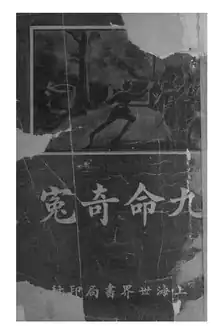A Strange Case of Nine Murders
A Strange Case of Nine Murders (C: 九命奇冤, P: Jiǔmìng Qíyuān, W: Chiu-ming ch'i-yüan) is a 1906 Chinese murder mystery novel[1] by Wu Jianren (Wu Woyao). Douglas Lancashire and Edel Lancashire's English translation was published in 1998.[2]

Plot
The novel opens within an action scene, where a group of men trying to burn their victim are engaged in a conversation. Bruce Doar, who wrote a book review of The Chinese Novel at the Turn of the Century, wrote that "Such an opening was unprecedented in Chinese fiction."[3]
Analysis
Gilbert Fong, the author of "Time in Nine Murders: Western Influence and Domestic Tradition", published in The Chinese Novel at the Turn of the Century, documented shifts in time.[1] Fong argued that the manipulation received inspiration from foreign models, Cantonese ballads, and traditional Chinese crime stories (gongan). Fong also stated that the "time inversion" technique appears more often than the previous literature about A Strange Case of Nine Murders indicates.[4] Robert E. Hegel, author of a book review of The Chinese Novel at the Turn of the Century, wrote that Fong corrected an opinion about A Strange Case of Nine Murders that had been written by Hu Shih.[1] Doar wrote that Fong's writing was "an especially solid piece of scholarship."[3]
Reception
Bruce Doar, who wrote a book review of The Chinese Novel at the Turn of the Century, stated that A Strange Case of Nine Murders was "regarded as one of the finest novels of the late Qing period."[3] Doar argued that "due to the opening, it was "one of the most innovative" novels.[3]
References
- Doar, Bruce. "The Chinese Novel at the Turn of the Century" (book review). The Australian Journal of Chinese Affairs, ISSN 0156-7365, 01/1982, Issue 7, pp. 199 - 201 (Available on JSTOR)
- Hegel, Robert E. "The Chinese Novel at the Turn of the Century" (book review). Chinese Literature: Essays, Articles, Reviews (CLEAR), ISSN 0161-9705, 07/1983, Volume 5, Issue 1/2, pp. 188 - 191.
- Yee, Cordell D. K. "The Chinese Novel at the Turn of the Century" (book review). Journal of Asian Studies, ISSN 0021-9118, 05/1982, Volume 41, Issue 3, p. 574
Notes
- Hegel, p. 190.
- "Sea of regret : China's first modern love story ; & A strange case of nine murders / by Wu Woyao (1867-1910) ; translated with introduction by Douglas and Edel Lancashire". Edinburgh University Library. Retrieved 12 July 2023.
- Doar, p. 201.
- Yee, p. 574.
Further reading
- Fong, Gilbert. "Time in Nine Murders: Western Influence and Domestic Tradition" in: Doleželová-Velingerová, Milena (editor). The Chinese Novel at the Turn of the Century (Toronto: University of Toronto Press; January 1, 1980), ISBN 0802054730, 9780802054739.